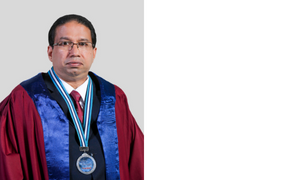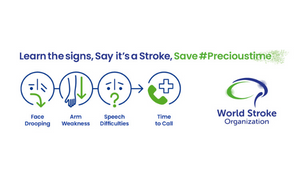
Oct 28 2022.
views 506
Q What is stroke?
Stroke occurs as a result of a sudden disturbance of the blood supply to a particular area of the brain resulting in death or damage to the brain nerve cells (neurons). The disturbance of the blood supply in most patients (85%) occurs as a result of blockage of a feeding artery by a blood clot (termed ischaemic stroke or infarction) and in others due to rupture of a feeding artery (termed haemorrhagic stroke). The term mini-stroke or TIA (transient ischaemic attack) is used when the stroke symptoms resolve rapidly as a result of spontaneous clearance of the blocked artery.

Dr Harsha Gunasekara
Q Why is time such an important factor when it comes to the treatment of stroke?
This is because there is a rapid loss of neurons after a stroke at a rate of 1.9 million per minute and the damage may be completed and irreversible within a few hours. The result could be either permanent disability or even death. Therefore, treatment has to be initiated immediately as every minute counts. The theme “SAVE #PRECIOSTIME” for this year’s World Stroke Day highlights this factor.
Q What are the causes of a stroke?
One or more risk factors will make a person susceptible to stroke. Risk factors for stroke and other non-communicable diseases (NCDs) such as coronary heart disease are quite similar. The world stroke organization has updated the top 10 stroke risk factors for stroke together with the frequency of their association with stroke. They are; high blood pressure (56 %), unhealthy (which means high in sugar, salt and saturated fats) diet (31%), high body mass index (24%), high fasting glucose (20%), air pollution (20%), smoking (18%), high LDL cholesterol (10%), kidney dysfunction (8%), alcohol use (6%) and low physical activity (2%).
Q How common is stroke compared to other NCDs?
Stroke is the 2nd leading cause of death globally and the leading cause of adult-onset disability. Every one in four people carry a lifetime risk of developing a stroke. 89% of global stroke-related death and disability occurs in lower and lower-middle-income countries like Sri Lanka. 80% of strokes occur in people with low or moderate absolute risk of cardiovascular disease. This stresses the importance of adapting preventive measures even when your risk is low. In Sri Lanka, annually, over 60,000 patients with stroke are admitted to state sector hospitals with around 4000 in-hospital deaths due to stroke. Hospital stroke registry data reveals that only less than 2% of patients receive urgent clot-buster treatment, predominantly due to delayed admission and only around 14% of patients have access to stroke unit care. Stroke units and stroke beds in the country are limited predominantly due to limited infrastructure facilities.
Q What are the signs of a stroke?
Knowing the “FAST” signs for recognition of stroke is the best way to remember the 3 commonest signs of stroke. These are;
F – Facial drooping
A – Arm Weakness
S – Speech Difficulties
T – Time to Call (for medical help)
If any of the 3 signs are positive, the patient should be taken to the nearest hospital with a CT scanner done immediately, even if the symptoms appear to improve.
Q What is the usual treatment procedure?
First step would be to identify the type of stroke by a CT scan. Clot-busting treatment will be given to eligible patients after assessment. All patients need essential supportive treatment to prevent the worsening of the stroke and prevent complications. Most patients will undergo rehabilitation by a multidisciplinary stroke team and this should preferably be done in a stroke unit.
Q How do you prevent a stroke?
Over 90% of strokes can be prevented by healthy lifestyle practices and in some instances through medications. The easiest steps in maintaining a healthy lifestyle are to stay away from both active and passive smoking and take alcohol in moderation (2 units a day for men and 1 unit a day for women). Next is to maintain a normal body mass index (18.5 – 24.9) and healthy waist circumference (less than 40 inches for men and 35 inches for women). Regular moderate physical exercise (e.g. brisk walking) for 30 minutes a day for at least 5 days a week is recommended. Regular exercise together with a healthy (in terms of both quality and quantity) balanced diet – rich in fibre, fruits and vegetables and low in saturated fats, salt and sugar helps to maintain a healthy weight. Get your blood pressure, blood glucose, cholesterol levels and heart rhythm checked and take treatment if advised by your doctor.

Q Is it true that after a stroke there is always a danger of another stroke?
One in four stroke survivors will suffer a second stroke. Therefore, all medications and healthy lifestyle practices should be continued.
Q What is your message to the public in general and caregivers of stroke patients?
Identify your own risk factors and follow the prevention methods in this article. Learn the FAST stroke signs and take immediate action if a stroke happens. Caregivers should encourage and ensure that patients continue their medications and healthy lifestyle practices even after recovery to prevent a future stroke.
By Dr Harsha Gunasekara Consultant Neurologist President – National Stroke Association of Sri Lanka
0 Comments